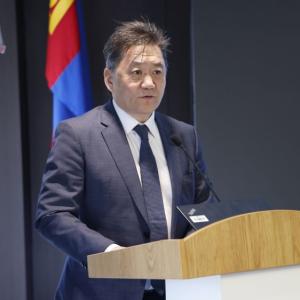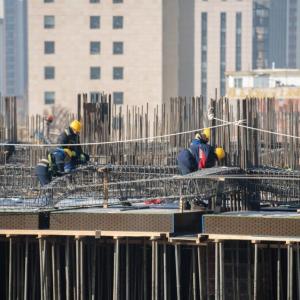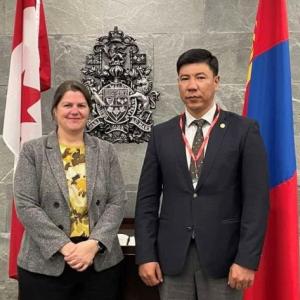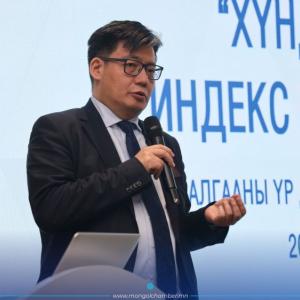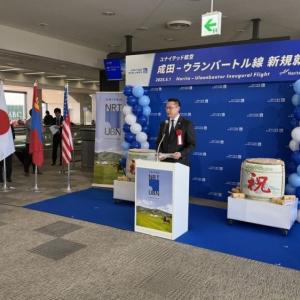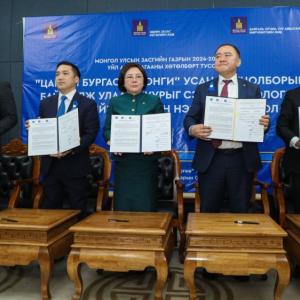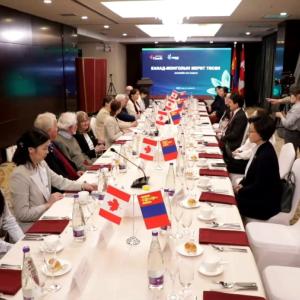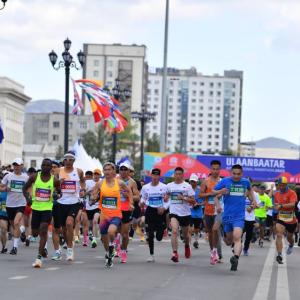From Concept to Construction: Designing Mongolia’s Steppe Arena
Society
Ulaanbaatar, April 7, 2023 /MONTSAME/. Only
three years ago in Mongolia, children who were passionate about ice skating and
playing ice hockey, and anyone with a strong interest in the winter sport,
would eagerly await the arrival of the winter season, which typically lasts
only three to four months.
Mongolian
Ice Hockey has been developing for 60 years. However, the athletes trained most
of the time in freezing cold winters in outdoor rinks or on the ice of the
frozen rivers due to the lack of an ice arena. It was a challenge that was
stopping the advancement of our hockey athletes. In 2021, the Steppe Arena was
constructed in the vast land of Mongolia, fulfilling a century-long dream not
only for hockey players, children, and youths but also for adults throughout
the country.
On
March 24, 2023, MONTSAME Mongolian National News Agency interviewed two distinguished architects from Canada who served as advisors for the
historic development of Steppe Arena in Ulaanbaatar, Mongolia.
Good
afternoon, Mr. Mark Hentze and Mr. Kevin Klippenstein. Can you give us a brief
introduction of yourself before we begin the interview?
-Mark:
My name is Mark Hentze. I'm an architect. I have specialized in sports facilities
my whole career, and this is my true passion. I've always loved that kind of
work. It's a way for me to continue in sports architecture because I have a
background as an athlete and was fortunate enough to play professional hockey.
Being a sports architect allows me to continue pursuing my passion for sports.
No one makes me go to work every day. It's just a joy to be there most of the
time.
-Kevin:
My name is Kevin Klippenstein. I am also an architect and have a specialty in
sports architecture. It is a little bit different from Mark’s experience, but
there are a lot of similarities at the same time. Working with Mark is really
fantastic. As we complement each other's weaknesses, we are able to fill in
gaps where one of us may be less experienced in a particular area, thus
allowing us to work together effectively. So, we end up being a well-rounded
team. I have been working as an architect for a number of years now. My
favorite aspect of sports architecture differs from Mark's perspective as an athlete.
While he approaches it from an athletic standpoint, I come at it from a
community point of view, aiming to give something special and unique back to
the location it's in.

Mr. Mark Hentze with Honorary Gold Medal of Mongolian Olympic Committee
Steppe
Arena opened a new opportunity for Mongolia. For the first time in its history,
Mongolia is hosting two world ice hockey championships after constructing
Steppe Arena, Olympic standard arena. Specifically, the IIHF World Championship
Division IV and the 2023 IIHF Ice Hockey U18 Asia and Oceania Championship.
What was your role in designing Steppe Arena?
-Mark:
Most importantly, I think that we can say collaboratively together is that our
role was we got to be part of a design team. We got to work with Tsagaan,
Munkhbat, and Zolboo as a team to create the Arena that picks up some of the
features typically found in the Canadian arena. Therefore, we collaborated
extensively with our Mongolian colleagues and friends to ensure their valuable
inputs were considered.
We
were working as a team on a design project and came up with the initial concept
together over the course of a week. Zolboo, Batmunkh, and Tsagaan had to do a
lot of work to complete the project. But I think that was the role of trying to
give a sensibility around creating a great Ice Arena experience.
-Kevin:
That is an excellent way of putting it in. Our
role was crucial as we were involved in the first indoor ice arena in Mongolia.
A large part of our role was to show the Mongolian team what made a successful
arena and what were some things to avoid. To bring the best design to Mongolia,
we successfully showed what we had done in other places and the lessons we had
learned.
-Mark:
When the Mongolian team came to Canada with their initial concept, there were
many great ideas in it. But there were also some things that we could help
improve on. The original design of the ice arena has seating further back from
the ice rink. What we're interested in is trying to create a really exciting
atmosphere. For Steppe Arena, we pushed the seating right up against the edge
of the hockey boards. The specter is almost on top of them, and the spectators
feel like they're a part of the game.
The
opening ceremony of the IIHF World Championship Division IV and the opening
game with Mongolia and Kuwait were great. I hope people loved experiencing ice
hockey at a high level for the first time in Mongolia. I have to say one thing
that really impressed me about the Mongolian people. The Opening Ceremony
started at 5 pm. We arrived at the Arena at 4 pm. The Arena was 2/3 fulled
already. In Canada, people show up 10 minutes before the game starts.
"It was a very pleasant surprise to see how enthusiastic the Mongolian fans were," said Kevin.
Yesterday,
it was fantastic to see both of you dressed in hockey jerseys of the Mongolian
Team.
-Kevin:
Yes! We both bought jerseys last night. It was
fabulous.
-Mark:
Hopefully, everybody in Mongolia is really
proud of Steppe Arena. Also, we're proud and privileged to be a part of it. So,
when we walked over, we saw the jersey. We just looked at them and said we
should support Mongolia because we really felt like a part of your team too.
 Mr. Kevin Klippenstein during interview
Mr. Kevin Klippenstein during interview
How
did you feel about working with Mongolian architects?
-Mark:
They are fabulously talented design architects.
-Kevin:
As Mark was saying, they are extremely talented. It was a pleasure working with
them. Also, it was a seamless experience as far as we were concerned.
-Mark:
Zolboo and his team are very talented. When we started working together in
Vancouver on the original concept designs, it was clear Zolboo was a very
skilled architect at the world-class level. I think our collective skills
created an arena with a very unique look.
How
many times have you visited Mongolia? What are your first impressions?
-Mark:
This is our first trip. We had hoped that we were going to be a part of the
delivery of the building during construction. But, of course, we weren't able
to continue due to the COVID-19 pandemic. We kept in touch with the group, and
stayed connected after following the Instagram account of Steppe Arena and its
website.
-Kevin:
Mongolian winter is much like Canada.
-Mark:
Maybe this is a good reason for the partnership. If they chose different
architects from another country, Mongolian winter might be a little bit cold
for them. But in reality, we are Canadian, a land of winter, hockey, ice
arenas, and figure skating. So, the weather is fine.
You
worked on many projects for Ice Arenas. So, which one was the hardest to
accomplish the desired results?
-Mark:
I was privileged enough to be a part of the architectural team that designed
Canada’s National Hockey Training Center. It was really hard for me because the
expectations were so high. You know, hockey in Canada is a religion. If you get
a chance to design the National Hockey Training Center in Canada, there are
many eyes on you. There are a lot of people that know a lot about ice arenas.
So, this was the hardest one for me. If somebody from Ulaanbaatar went to the
WinSport facility in Calgary, they would see some similarities between what
Kevin, I, Zolboo, Batmunkh, Tsagaan, and the whole team came up with here at
Steppe Arena. Yeah, I find this to be the most difficult challenge for
me.
What
are the unique features of the Steppe Arena in your opinion?
-Kevin: I think unique features are the things that the Mongolian team brought to the project. There will be water fountains for the summer and an outdoor plaza that will be an outdoor skating. They will have skate rentals. It's kind of a tricky site because there's a big elevation difference. I think handling it largely through Zolboo and how he fitted it onto the site was magnificent.
One of the unique things about this arena is not just about what's on inside but how it relates to the Plaza and the other things around it.
-Mark:
I agree with that. I think there are a few other things that stick out to me.
Last night, we observed the Opening Ceremony, which was the pregame show with
all the lighting projecting onto the ice and stuff. Then, I told Batmunkh that
this is as good as Canada and USA for NHL professional hockey. During our
conversation, we noted how the seating is situated remarkably close to the ice
surface and how the steep angle of the seats adds to the excitement of the
experience. So, the sightlines are way better than in standard arenas. I think
the other neat thing about the Steppe Arena is the curved roof design. What we
were trying to do together was to create an atmosphere that would feel as if
you were in a crowd of way more people than you were in.

On
March 24, 2023, Honorary Gold Medals of the Mongolian Olympic Committee were
conferred upon Mark Hanson and Kevin Klippenstein for their valuable
contribution to constructing Steppe Arena in Mongolia. We asked them for their
impression of the medals, and they answered:
-Kevin:
This morning, we received these medals for our contributions to the sport. Mark
and I were very touched. We did not know that we were going to get these
medals. It is a great honor for us and very humbling.
-Mark:
Beyond all of its impressive features, what sets it apart is its ability to
make a meaningful contribution to the community. But what’s really exciting
about it is that the Arena opened the opportunity to all boys and girls in
Mongolia to become hockey players, figure skaters, and speed track skaters in
their lives. As a result of it, Mongolian Olympic Committee recognized us for
that. We are very humble and unexpected.
Did
you face any challenging situations while working on the project of Steppe
Arena?
-Mark: No, this is exactly the point we are talking about. The Mongolian team visited Canada and toured various arenas across the country. Then, we worked altogether in my office. So, all of us were around the table together. I think this made it cohesive because we all understood together, such as the goals and objectives for Steppe Arena. Zolboo had to take two or three years to finish the design and construction. But as a concept, it came together very cohesively because of successful teamwork.
I would work with these guys anytime and anyplace since they are fabulous. They listen very well and have really good key ideas.
Mark
also has a history as a hockey player, playing both for his universities in
Calgary and British Columbia and professionally for HC Zweirbruken in Germany
from 1984 – 1986. During the interview, Mark said about Mongolian Hockey Team:
-Mark:
While watching the game with my son, who is also a hockey player, we were
impressed by the Mongolian team's exceptional skating skills and intuitive
understanding of the game. We discussed the team's impressive performance
throughout the game. Given that ice hockey is still an emerging sport in
Mongolia, it is understandable that the Mongolian team aims to further improve
their shooting and stick-handling skills. Mongolian ice hockey players have had
to train on rivers and frozen lakes in bitterly cold winters. It was hard to
get better at their skills. But they were impressive. We interviewed last night
on TV, and the guy asked me at the end of the interview, he asked, "What
do you think the score is going to end up like?” Then I said 7-0. But the
moment the eighth goal was scored, I felt a rush of joy.
From
an architect's perspective, how do you see the Mongolian landscape, especially
of the capital city Ulaanbaatar?
-Kevin:
It is such a beautiful setting here. We really
enjoyed touring around. We haven't been here very long yet. Despite it being
the second half of the day, we keep commenting on the breathtaking natural
beauty surrounding us - the vast steppes stretching out before us and the
majestic mountains rising up in the distance. We are thoroughly enjoying our
time here, particularly enjoying the impressive architecture of some of the
buildings. I am already looking forward to returning when the weather is
warmer, eager to explore more of this stunning place.
-Mark:
The landscape reminds me of where we live in British Columbia. It is just like
the way that the hills jot up into the sky. The architecture has been
interesting to see here. Yesterday, we had a chance to go to Chinggis Khaan
Museum, which is a stunning building.
In
addition, do you have something to say to Mongolians?
-Mark:
Yes, now you have Steppe Arena in Mongolia. Try
hockey, speed skating and figure skating because you will love them.
-Kevin:
As the community becomes familiar with the new
Arena, I have no doubt that they will come to appreciate and enjoy its
fantastic facilities. From hockey and skating enthusiasts to families seeking
fun and recreation, the Arena is something for everyone to enjoy.
As
Mark said earlier, I was humbled and appreciated having had this opportunity.
Our visit to the Arena was truly memorable, and a number of Mongolians shared
with us their enthusiasm for this new addition to the Mongolian sports
culture. The ice arena is very rare in Mongolia. In
Canada, hockey and arenas are ubiquitous, and it is true that building a new
arena might not be the most remarkable event in Canada. However, in Mongolia,
where winter sports are still emerging and developing, the construction of the
Steppe Arena was a significant and exciting milestone. To be a part of it is
very humbling, and we enjoyed it very much.
-Mark:
Normally, when we finish a project, people are
generally pretty happy, and the owners and the clients shake hands and say
thank you, well done, and it is a great project. Yesterday's event at the
Steppe Arena was truly special, as we saw three thousand people come together
to cheer on Team Mongolia. The energy and excitement in the Arena were
palpable, and it was a real joy to see so many smiling faces there. As for the
unexpected honors and recognition that we have received, it is certainly a
surreal experience. While we are humbled and grateful for the recognition, we
are also somewhat uncomfortable with the attention, as we are not accustomed to
being in the spotlight. But we are deeply touched by the warmth and generosity
of the Mongolian people and will cherish these memories for years to come.
That’s been fantastic!
Thank you!


 Ulaanbaatar
Ulaanbaatar



